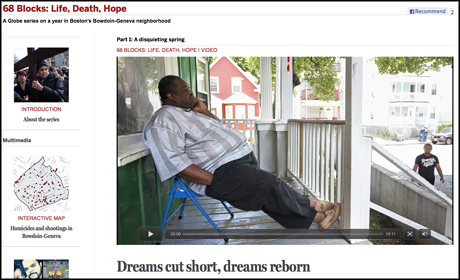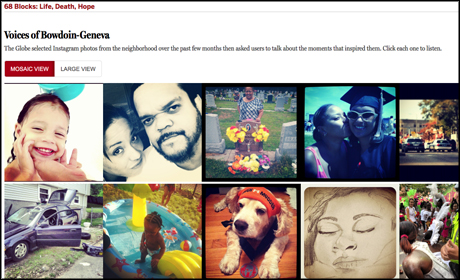According to the Globe, the Bowdoin-Geneva neighbourhood, for the last 25 years, "has consistently been more dangerous than Boston as a whole".
So in a bid to really reach the heart of the neighbourhood and hear the stories within, the journalists moved themselves in to find out "why violence persists where love and loyalty also run so strong".
The main result of their time spent in the neighbourhood was a five-part, 25,000 word story, the last part of which was published today.
But the Globe has also incorporated other storytelling techniques to share the many stories they uncovered about living in Bowdoin-Geneva.
Online, the Globe produced a web 'special' titled 68 Blocks: Life, Death, Hope, which features a package of related content ranging from short "notebook" posts through to interactive graphics, photo 'walk-throughs' of the neighbourhood and multimedia packages.

One particular feature "Voices of Bowdoin-Geneva", offers an interesting example of a news outlet engaging with Instagram, as well as adding further context and character to the images.
The feature was the result of an Instagram-driven tool called Snap, which records each Instagram photo captured and shared within the neighbourhood.
Journalism.co.uk has previously reported about how the Boston Globe used Snap to display onto a wall all the Instagram photos captured in the local area, and how this was being fed into its newsgathering process, such as during Hurricane Sandy.
And when it came to the Bowdoin-Geneva project, the technology was also put into practice.
Creative technologist at the Globe Chris Marstall told Journalism.co.uk that the idea was to not just embed themselves in the physical neighbourhood, but to also "embed ourselves in the virtual Bowdoin-Geneva as well, and kind of really observe what's happening on social media".
The focus of the feature was on "the natural fabric of peoples lives", and hoped to offer "a way to connect with commonalities instead of all the differences that exist".
He added that at the start of the project the Globe looked into using a number of different platforms, including YouTube, Twitter, Facebook and thisis50.com, but "in the end we decided that Instagram was really the most expressive platform".There is a lot of activity in the neighbourhood and it showed this very intimate look at people's lives, their kids, their apartments, what they had for dinner, their special momentsChris Marstall, The Boston Globe
"There is a lot of activity in the neighbourhood and it showed this very intimate look at people's lives, their kids, their apartments, what they had for dinner, their special moments".
Using the Snap tool an editor was then able to select certain Instagrams, based on those which "looked especially interesting, especially resonate, especially expressive," he said.
"The story is about a neighbourhood that's kind of in crisis, it's kind of darkened by violence, and I think a lot of the readers can feel like that's just another planet, and it's hard to identify with and I think that what Instagram allowed us to do is in a kind of magical way."
With the images selected, recordings of the creators speaking about "the moments that inspired them" were then added to the grid-style feature, which is presented in either a tile or larger image format.

This combination of photos and audio "is to show people just being people, being themselves, in a way that is incredibly identifiable and incredibly emotional", Marstall added.
"It's so touching, it makes the violence all the more shocking to sort of have an emotional connection to people that are living in this neighbourhood."
Marstall added that the familiarity of the Instagram brand played "a big part of it too".You need to figure out what was the context, what does this mean, and so to me this was a really classic affirmation of that a news organisation still has a role in this era of people self-reporting because we can add so much to it in terms of context and sense and meaningChris Marstall, The Boston Globe
"You know how these photos came about, they came about with their phones, taking pictures of their lives and uploading them. There's a real authenticity there and it's to me at least, it's a hook.
"Just the fact it's Instagram, because you know where these photos came from and how they were taken and it's a tool that people just know how to use."
He added that the approach to the overall project was one which could be applied in different cases.
"I feel like we added value, we added meaning and context to Instagram ... I think that to me this is how a news organisation has to do social media. You have to use it to find news, find stories, find people, and then once you've done that you need to do reporting on that.
"You need to figure out what was the context, what does this mean, and so to me this was a really classic affirmation of that a news organisation still has a role in this era of people self-reporting because we can add so much to it in terms of context and sense and meaning."
Free daily newsletter
If you like our news and feature articles, you can sign up to receive our free daily (Mon-Fri) email newsletter (mobile friendly).
Related articles
- News subscriptions hit a snag amid cost-of-living crisis, RISJ report finds
- Average revenues up by 20 per cent for UK independent news publishers
- Five sources of inspiration for journalists on social media
- Tips from Slovakia's REFRESHER: 'The key to Gen Z is language'
- Avery Anapol, commissioning editor at The Conversation, on engaging younger audiences with academic content









